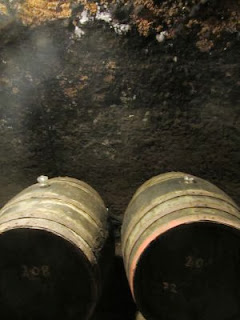The tour takes you through the labyrinth of cellar tunnels cut into the soft volcanic rock of the hillside. There are over 700 m of cellar at Konyves, filled with around 800 oak barrels. The walls are covered with a mould (Cladosporium cellare), which is white when young but grows into a thick black layer. The mould feeds off the alcohol vapours from the barrels. It is important, because it regulates the humidity (88-95%) and temperature (a constant 12°C) in the cellar.
Three wines of increasing sweetness are usually tasted on these tours. The first is Furmint, a very dry and unremarkable white wine made from the Furmint grape variety. The second is a Muscadet, from the French grape of that name (the only one of the half-dozen Tokaji grape varieties that does not originate in Hungary), which is here really to give a taste of a standard sweet wine. The star is saved to last – the distinctive Azsú (bottle pictured). This is the sweetest naturally-made wine, with 70% sugar. The sweetness is complex, however, with honey, tropical fruit (citrus/apricot) and nutty flavour notes. It’s nectar.
The grapes that give Azsú its character come from the Furmint vines, but they are infected with the fungal mould Botrytis cinerea. This concentrates the grape’s sugar content and flavour. I was in the vineyard in early October and the grapes (photograph) are still growing – the shrivelled brown Azsú grapes are hand-picked in early November from the Furmint bunches. It’s like making wine with juicy raisins. The bottle is labelled ‘5 puttonyes’, which traditionally referred to the number of buckets of Azsú grapes added to 130 litres of must in a barrel (the range is from 3 up to a very sweet 6); now it refers to the sugar level. The wine is aged for 3-6 years in the barrel.
Out in the vineyard, we saw some curious pipes in the ground. The nearest one in this picture is 12 metres above the wine tasting area in the corner of the cellar, which is carved out of the hillside below the vineyard.
The conditions are not right to make the Azsú every year, just one in every two or three years; in those years they make a lot of Furmint. They have kept samples from all the Azsú years back to 1895 in the Konyves cellar. It’s a stroll back in time.
I would like to thank Miklós Dombos, of the Institute for Soil Sciences and Agricultural Chemistry in Budapest, and György Zsigrai, of the Research Institute for Viticulture and Oenology in Tokaj, for arranging the visit to the cellar.
LIFE website - funding environmental and nature conservation projects in the European Union:
http://ec.europa.eu/environment/life/






No comments:
Post a Comment